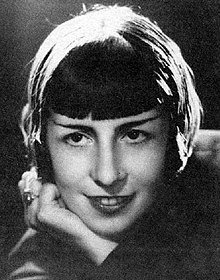María Luisa Bombal
María Luisa Bombal | |
|---|---|
 | |
| Born | June 8, 1910 |
| Died | May 6, 1980 Santiago |
| Education | University of Paris |
| Occupation | Writer |
María Luisa Bombal Anthes (Spanish pronunciation: [maˈɾi.a ˈlwisa βomˈβal]; Viña del Mar, 8 June 1910 – 6 May 1980) was a Chilean author.[1] Her work is now highly regarded, incorporating themes of eroticism, surrealism and feminism, and she ranks among a small number of Latin American female authors whose works received worldwide acclaim.[2] She was a recipient of the Santiago Municipal Literature Award.
Biography[]
María Luisa was the daughter of Martín Bombal Videla and Blanca Anthes Precht.[2]
Her first years in school were in a girl's catholic school and after her father's death in 1919, María Luisa, only being an 8-year-old girl, went alongside her mother and sisters to live in Paris, where she finished her studies at college Sainte Geneviève. At the University of Paris she studied literature and philosophy. She also attended the Lycée La Bruyère and the Sorbonne at the University of Paris. There, she was part of a different cultural and artistic panorama, place where she gained interest in literature and of course, in writing novels. After finishing her university studies she came back to Chile, reuniting with her mother and sisters again.
She also studied violin with the music teacher Jacques Thibaud and drama with Charles Dolan.
In 1938 she published one of her most famous and most important novels in Chilean literature, La amortajada, which earned her the Premio de la Novela de la Municipalidad de Santiago (Novel prize of Santiago's Municipality). Also, when she lived in United States, with views on the American book market, she wrote a novel in English, called The House of Mist, which was a translation to English of her novel La última niebla.[3]
Personal life[]
Upon her return to South America she married a pioneer in civil aviation, , who did not share her interest in literature. During their marriage, Bombal began to suffer from depression, and attempted suicide. In 1933 she married the homosexual painter Jorge Larco, forming with him a lavender marriage. With the help of friends, Bombal fled the country to Argentina, where in 1933 she met Jorge Luis Borges and Pablo Neruda in Buenos Aires. In 1937 she returned to Chile due to the beginning of a divorce trial. In 1941 she acquired a revolver, went to the Hotel Crillón and waited for Eulogio, her lover. When he came out, she shot him three times in the arm. She went to trial; however, Eulogio exempted her from all guilt, for which the judge acquitted her. Years later, on María Luisa's own words, she said that he ruined her life, however, she never forgot him. Later on, she moved to United States, where she married the French count, Rafael de Saint Phall, whom she had a daughter with, called Brigitte. She lived there until 1971. She then returned to South America; living first in Argentina (helped by Pablo Neruda, who was also living there), where she met important men of letters, and then in Viña del Mar, Chile. There, on 18 September 1976, Bombal again met Jorge Luis Borges.[3]
Death[]
In her final days, which she spent in Chile, Bombal developed an alcohol abuse. This drinking problem forced her to repeatedly visit the hospital for a liver disease. She remained in Chile until 1980, dying the same year on May 6 in Santiago, victim of a huge gastrointestinal bleeding.[4]
Distinction between femininity and masculinity in her works[]
In every novel and story written by María Luisa, there is a strong distinction between how women and men think and behave. We can see this clearly, when in most of her works, women and men characters are separated by a huge gender gap and the relationships between these characters are always troubled or flawed. For Bombal, femininity is a symbol of uniqueness, more related to nature, emotions and intuition, very different from how masculinity is represented, where men are described as stronger and wiser, at the moment of facing problems.[5]
Selected works[]
Novels
- La última niebla (1934)
- La amortajada (1938)
- House of mist (1947, only in English)
Stories
- Las islas nuevas (1939)
- El árbol (1939)
- Trenzas (1940)
- Lo secreto (1944)
- La historia de María Griselda (1946)
Chronicles
- Mar, cielo y tierra (1940)
- Washington, ciudad de las ardillas (1940)
- La maja y el ruiseñor (1960)
Other writings
- Reseña cinematográfica de Puerta cerrada (1939)
- En Nueva York con Sherwood Anderson (entrevista) (1939)
- Inauguración del sello Pauta (1973)
- Discurso en la Academia Chilena de la Lengua (1977)
References[]
- ^ Echevarría, Roberto González (ed.) (1997). The Oxford book of Latin American short stories. New York City; Oxford: Oxford University Press. p. 233. ISBN 0195095901.CS1 maint: extra text: authors list (link)
- ^ Jump up to: a b Amoia, Alba (ed.) (2002). Knapp, Bettina L. (ed.) (ed.). Multicultural writers from antiquity to 1945 a bio-bibliographical sourcebook. Westport, Connecticut: Greenwood Press. pp. 34–37. ISBN 0313016488.CS1 maint: extra text: authors list (link)
- ^ Jump up to: a b "María Luisa Bombal (1910-1980)". Memoria Chilena. Retrieved 28 June 2019.
- ^ Redaccion, Equipo de. "María Luisa Bombal: Tres formas para rescatar del olvido a la talentosa escritora viñamarina". La Otra Voz (in Spanish). Retrieved 28 June 2019.
- ^ Memoria Chilena. "Estudios de género". www.memoriachilena.gob.cl. Biblioteca Nacional de Chile. Retrieved 28 June 2019.
Further reading[]
- Pérez Firmat, Gustavo. Tongue Ties: Logo-Eroticism in Anglo-Hispanic Literature. Palgrave, 2003.
- 1910 births
- 1980 deaths
- Chilean novelists
- Chilean people of French descent
- Chilean people of German descent
- People from Viña del Mar
- Chilean women novelists
- 20th-century women writers
- 20th-century novelists